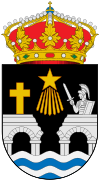Negreira
| Negreira municipality | ||
|---|---|---|
| coat of arms | Map of Spain | |

|
|
|
| Basic data | ||
| Autonomous Community : |
|
|
| Province : | A Coruña | |
| Comarca : | A Barcala | |
| Coordinates | 42 ° 54 ′ N , 8 ° 44 ′ W | |
| Height : | 117 msnm | |
| Area : | 115.3 km² | |
| Residents : | 6,827 (Jan 1, 2019) | |
| Population density : | 59.21 inhabitants / km² | |
| Postal code : | 15830 | |
| Municipality number ( INE ): | 15056 | |
| administration | ||
| Mayor : | José Blanco Pazos ( PP ) | |
| Address of the municipal administration: | Concello de Negreira. Rúa do Carmen 3 | |
| Website : | www.concellodenegreira.gal | |
| Location of the municipality | ||

|
||
Negreira is the capital of the community association of the same name (concello) in the province of A Coruña of the Autonomous Community of Galicia . It is west of Santiago de Compostela .
history
The establishment of the first settlement in the Negreira area resulted from the strategically important location. It is determined by the situation above the Río Tambre as well as on the road "per loca maritima" on the one hand (main road to the coast, from Grandimirun , today Brandomil , to Aquis Celenis , today Caldas de Reis ) and on the other hand the embankment along the Tambre, which Connects inland with the coastal region around Noia .
Pre-Roman activities can be found throughout the A Barcala area. Early historical evidence can be found with a megalithic complex on Monte Corzán, with remains of Castro settlements in Logrosa, Vilachán, Xallas and Broño as well as with the dolmen and mámoas of Espiñaredo (a stone complex of 32 stones, 32 meters in diameter, up to 5 meters high). Furthermore, two prehistoric statues, broken off at belly level, were found in Logrosa in an important settlement of the Castro culture . They are now in the museum in Santiago de Compostela. The settlement Nicraria Tamara is mentioned for the Roman times , at that time silver mines were also exploited here.
In 876, Negreira changes to the possession of the Compostelan bishop Sisando by royal decree. In 979 Normans attacked the Galician coasts and the city was wiped out. After surviving the threat from the Normans and Moors , the city was rebuilt in 1113.
The Catholic kings granted the place a royal privilege called Fuero Real, which ensures Negreira independence from the Archbishop of Compostela. Charles V renewed the privilege in 1520 .
Attractions
In addition to the Pazo da Albariña mansion , the Pazo do Cotón stands out in the cityscape. It is on the way to Fisterra , the Camino Real, and was built between the 17th and 18th centuries. At the Porta da Capela it spans the street with three arcades , the upper wall is crenellated.
Demographics

economy
The economy is characterized by agriculture, the main crops are corn , potatoes and vegetables. A significant part of the community area is reserved for pasture farming. The livestock consists mainly of cattle and especially dairy cows. The dairy industry is therefore important. The dairy farmers' cooperatives founded the Feiraco company, today one of the largest companies in the Galician dairy industry. Tungsten was mined here during the Spanish Civil War and World War II . The mines are closed today.
Places belonging to Negreira
San Tomé de Alvite, San Vicente de Aro, San Cristovo de Arzón, San Martiño de Broño, San Pedro de Bugallido, San Fiz de Campelo, Santa Cruz de Campolongo, Santa María de Covas, San Pedro de Gonte, San Estevo de Landeira, San Martiño de Liñaio, San Xulián de Logrosa, Santa Olalla de Lueiro, San Mamede da Pena, Santa María de Portor, San Pedro de Xallas, San Mamede de Zas
Web links
- Stage description Camino a Fisterra: Santiago de Compostela - Negreira (Spanish)
- Stage description Camino a Fisterra: Negreira - Olveiroa (Spanish)
Individual evidence
- ↑ Cifras oficiales de población resultantes de la revisión del Padrón municipal a 1 de enero . Population statistics from the Instituto Nacional de Estadística (population update).



